![]()
Click on the "Get Acrobat" button to download a FREE copy of Acrobat Reader.
Enabling the Networked Home
The Coactive Connector® Residential Gateway
Overview
The Networked Home has become recognized as the next forefront of the networking revolution, where consumer technology and Internet infrastructure intersect to change the way we lead our lives. Much attention has been focused on the building blocks of this new world: Internet appliances, wireless devices, and home networking technologies.
Recent attention has turned to the building block at the heart of the Networked Home: the residential gateway. As its centrality is acknowledged, the residential gateway has engendered a great deal of discussion and questions. Which technologies will it support? Where will it sit in the home? What services will it enable? Who will bring these services to the mass market?
This white paper outlines a system solution that uses the residential gateway to deliver viable e-services to the Networked Home today. This solution is based upon Coactive Networks™ experience as the first company to deliver a full-service residential gateway, and the first company to deploy these consumer e-services to the mass market.
The Networked Home
At the highest level, the residential gateway makes the Networked Home possible by providing a central point of connectivity between in-home devices and a wide-area Internet access network. It allows in-home devices to access information from the Internet, and it allows the consumer to access home information from virtually anywhere.

Accessing data from the Internet is a straightforward proposition -- from a PC at work, an airport kiosk, an Internet café, or a wireless phone. There are also several ways for the Internet to connect to homes -- predominantly dial-up modem today, with high-speed broadband options such as DSL, cable modem, and wireless undergoing aggressive deployments. Less standard and familiar, however, are the means for establishing connections within the home and then extending those connections outside the home. This is the realm of the residential gateway.
Home Networks
While there are many ways to classify home networks, the most important distinction is that different technologies are designed for different services: data, entertainment (audio/video), and control.
Home data networks, like those in an office environment, provide high-speed connectivity for computers. Entertainment networks allow the streaming of audio and video from one location to another within the home. And home control networks let devices such as thermostats, light switches, security systems, and home appliances talk to each other and to the Internet.
In new homes, all of these networks are often simply built into the walls, using twisted pair wiring. In already-built homes, networking technologies either use existing wiring, such as telephone or electrical wires, or they transmit data wirelessly, using an antenna.
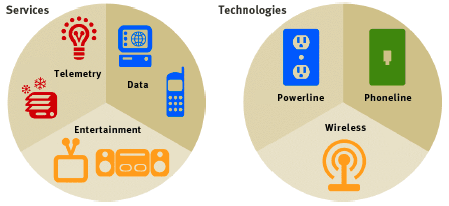
The Residential Gateway
Although home networking technologies can be used in a variety of ways, the Networked Home vision goes far beyond linking one PC to another or to the family printer. The Connected Home is about using this technology to enable a new class of e-services by connecting the Internet to every device and appliance in the home. The central product powering these e-services is the residential gateway.
The Coactive Connector® residential gateway uses every type of existing home wiring to provide maximum flexibility in reaching all these devices and appliances. By acting as a hub, router, logger, and controller, all rolled into one inexpensive networking product, the Coactive Connector is able to deliver an amazingly wide range of services.
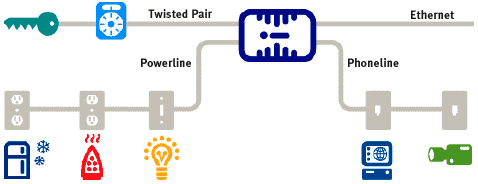
Telemetry E-Services
Of the many types of e-services enabled by the residential gateway, Coactive Networks focuses on telemetry e-services, those associated with remote access to home control networks. While less familiar to traditional networking companies used to "moving bits," telemetry e-services -- and the practical consumer benefits they deliver -- are poised to become the defining elements of the Networked Home.
Service providers such as electric utilities and telephone companies are today driving mass deployments of residential gateways. A convergence of factors places these providers at the forefront of this emerging market, and makes them a key driver in defining service offerings. The services first seeing mass deployments are therefore those such as energy management and security, services that create a valued role for the service provider, complement business models, and relate to current service offerings. These telemetry e-services deliver the first phase of the Networked Home, while working within existing structures to meet real-world revenue and deployment requirements.
Following are some of the common elements of service provider approaches to the installation, configuration, and expansion of telemetry e-services delivered through the Coactive Connector residential gateway.
Service Bundles
Typically, telemetry e-services are introduced through promotional programs similar to those used in added-value telephony services such as caller ID. Consumers may learn about Networked Home offerings through billing inserts or as part of a territory-wide advertising campaign. Bundles of services may be built around a theme such as energy management or home security. The marketability of these service offerings is based on their ability to deliver key consumer benefits: convenience, savings, and peace of mind.

E-service offers often will include a start-up or installation charge to offset initial costs. As with wireless phone, broadband or cable deployments, this charge may be waived or reduced, since service providers will reap ongoing returns from recurring monthly service fees.
Gateway Installation
Once the consumer has signed up for a service bundle, the Coactive Connector residential gateway is installed as a central infrastructure component. As with similar products, such as satellite TV receivers or cable modems, the Coactive Connector can be installed either by the consumer or by a professional technician. Typically, a technician is required only if the service delivered is one that cannot tolerate interruption, such as reading of the energy meter.
Professionally installed gateways are usually mounted on the wall in an out-of-the-way location such as the electrical panel or phone closet. The only requirement is that a phone and electrical connection be handy. A consumer who installs a gateway can place it anywhere near a phone and electrical outlet, or in the case of broadband, near the computer and broadband modem.
Home Device Installation
Certain services, such as automated electric meter reading or remote thermostat control, require the installation of "ssmart" home devices to communicate with the residential gateway. These home devices too can be installed either professionally or by the consumer. However, though the installations are no more complex than most do-it-yourself home improvement projects, they may involve exposure to AC electrical wiring and therefore are typically handled by professionals.
Other services, such as appliance control, security, and safety alert services, simply involve placing a plug-in module between the existing appliance and the wall outlet, or in some cases adding a new device, such as a water, motion or temperature sensor. Meanwhile, manufacturers are set to deliver a new generation of appliances, from refrigerators to dishwashers to alarm clocks, that include advanced built-in communications. These appliances automatically communicate with the gateway simply by being plugged in.
Once home devices are installed, the consumer goes to a Web page or calls a toll-free number and specifies preferences for each device, appliance or system.
Remote Home Access
Consumers can access all home systems from any Internet-enabled device. The most popular of these are Web browsers and wireless phones, using touch tone, alphanumeric paging, text messaging, or WAP. WAP in particular is currently underutilized and offer an ideal "remote control" window into the home. Other Internet interfaces include PDAs, pagers, and email alerts.
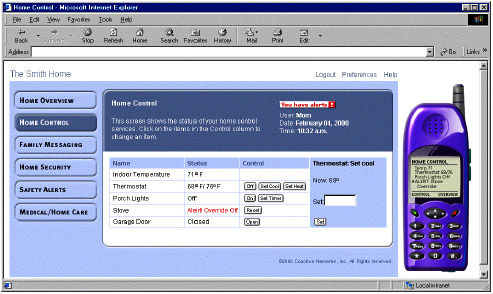
Service Examples
The following examples of actual telemetry e-services highlight the convenience, savings, and peace of mind possible with a Networked Home enabled by the Coactive Connector residential gateway:
![]() Convenience
Convenience
- Turn up the heat on the way up to the cabin, so the house is warm before you arrive.
- Open the garage door from work to let the delivery man drop off a package.
- Override the sprinkler system and reprogram it remotely when an unexpected storm hits while you're away.
- Display family email messages on the thermostat's LCD pad.
- Leave messages for the babysitter or the kids, from the road or from work.
![]() Savings
Savings
- Sign up for lower energy prices by enabling moderation of usage during peak periods.
- Receive security, energy, and other alerts so you can act before incurring fines or penalties.
- Save big by signing up for home security, Internet access, and electricity from a single provider.
- Get discounts on major appliances that support remote diagnostics and repairs.
- Schedule repair visits before malfunctioning appliances waste energy or cause other problems.
![]() Peace of mind
Peace of mind
- Keep tabs on the kids by getting logged entry times and exception alarms.
- Receive alerts before water leakage or unusual temperatures can cause home damage.
- Protect your family with constant monitoring for smoke, carbon monoxide and other safety concerns.
- Be there for elderly relatives by setting up alert systems to notify you of unusual events or inactivity.
- Know that your loved ones can hit a personal alarm pendant and reach you instantly.
Device Examples
The installation of a residential gateway is quick and easy, and the gateway itself is an unobtrusive addition to the home. Simply replacing light switches or using a smart plug with standard appliances transforms any house into a digitally Networked Home. The following describes some typical smart devices and how they work with the residential gateway to deliver telemetry e-services.
![]() Thermostat
Thermostat
Installation: A service provider installs a "smart" thermostat. The existing wiring remains intact and is used to communicate to a module at the furnace or AC unit, which has a direct link to the power line.
Features: Check the current temperature and enter maximum and minimum temperatures from a Web browser or WAP phone. If the temperature falls outside these limits, receive an instant alert by email, page, or alert to a WAP phone, while the Web interface shows an alarm status. Send an email message for display on the thermostat's LCD panel, which then serves as an electronic post-it note for the entire family.
![]() Smart light switch
Smart light switch
Installation: Either the consumer or a technician replaces the existing light switch with a "smart" switch, available at the local hardware store or distributed by the service provider as part of the residential gateway package.
Features: Remotely control lights and check on status from a Web browser or WAP phone. To help control energy bills, place lights on a schedule, or set automatic on/off commands for the switch.
![]() Home appliances
Home appliances
Installation: Even technologically challenged consumers can turn an everyday appliance into a "smart" appliance by plugging it first into a plug-in module and then directly into the wall. These smart plugs are offered by the service provider and can also be purchased at local electronics stores.
Features: Remotely switch an appliance on or off, and check the current on/off state from a Web browser or WAP phone. Set a maximum limit of the time for the appliance to remain on. If the appliance remains on for over this limit, either automatically shut it off or receive notification and on/off control options from the Web or a WAP phone.
![]() Energy meter
Energy meter
Installation: Installed by the utility company, a "smart" energy meter is mounted in the electrical panel. Alternatively, an existing meter can be retrofitted with an under-the-glass card that relays energy data over the power line.
Features: Consumers and utility providers can view whole house energy usage from a Web browser and compare hourly, daily, and weekly usage with historical data. See energy cost increases in real-time as appliances are turned on and off. Receive a discount on power in return for enabling automatic reduction of key energy-using devices during peak periods. If household energy usage exceeds maximum limits, receive an instant alert by email, page or alert to a WAP phone, while the Web interface shows an alarm status.
![]() Motion detector
Motion detector
Installation: Consumers can simply plug the motion detector into a wall outlet.
Features: Arm or disarm a burglar alarm function from a Web browser or WAP phone. If motion is detected while the "system" is armed, receive an instant alert by email, page or alert to a WAP phone, while the Web interface shows an alarm status. Alternatively, for elderly relatives living alone, if motion is not detected for a pre-determined period of time, the family member receives an instant alert.
![]() Safety sensors
Safety sensors
Installation: Consumers can simply plug the sensor into a wall outlet.
Features: If water, high or low temperatures, carbon monoxide, or smoke is detected, receive an instant alert by email, page or alert to a WAP phone, while the Web interface shows an alarm status. Avoids damage due to flooding basements, leaky, broken or frozen pipes, or dangerous home conditions.
The Coactive Difference
These devices and features are not in themselves new to the market. What is new is the Internet connectivity, low cost, and easy setup of these services when they are all networked together and enabled by a single piece of technology -- the Coactive Connector residential gateway.

The Coactive Connector represents a revolutionary new class of networking product. Built upon IOConnect Architecture™, Coactive's patent-pending technology, the Coactive Connector is an intelligent central coordinator and translator for the Networked Home. Three key features distinguish the Coactive Connector in this role:

The Coactive Connector accommodates not only three different home networking media (power line, phone line, and twisted-pair wire), it also accommodates different protocols. To connect to everything from thermostats, to washing machines, to PCs, the gateway supports all leading protocols and key networking technologies.
![]()
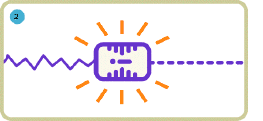
The Coactive Connector is an intelligent device that can translate protocols, log data, and run programs to enable services in the home. More capable than a simple bridge, yet more reliable and inexpensive than a computer, the Coactive Connector is a true full-service residential gateway.
![]()
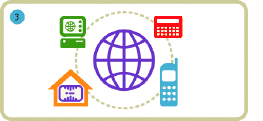
The Coactive Connector incorporates a software interface designed from the ground up to securely scale to millions of homes and to deliver connectivity to any kind of Internet device. Building on open standards and the IOConnect Architecture, the Coactive Connector provides the flexibility, security, and reliability necessary to deliver the Networked Home to the mass market.
Coactive Networks has developed these key features as part of the advanced, third-generation platform of the Coactive Connector residential gateway. As the leader in telemetry e-services, Coactive is dedicated to a singular vision: Connecting Networks to the Real World™. For service providers such as telcos, electric utilities and broadband providers, this means added revenue streams, increased subscriber gains, and a sustainable advantage in a competitive environment. For consumers, this means an ever-expanding new world of Internet services that make the Networked Home of the future a reality today.